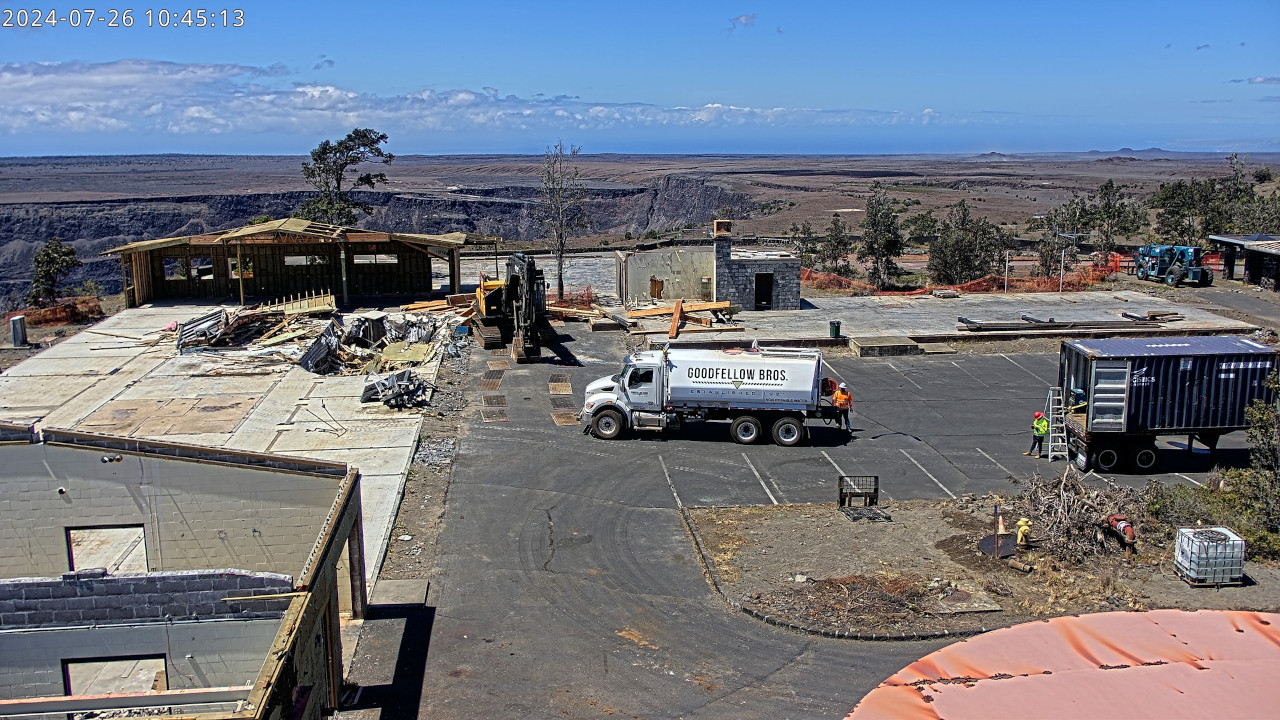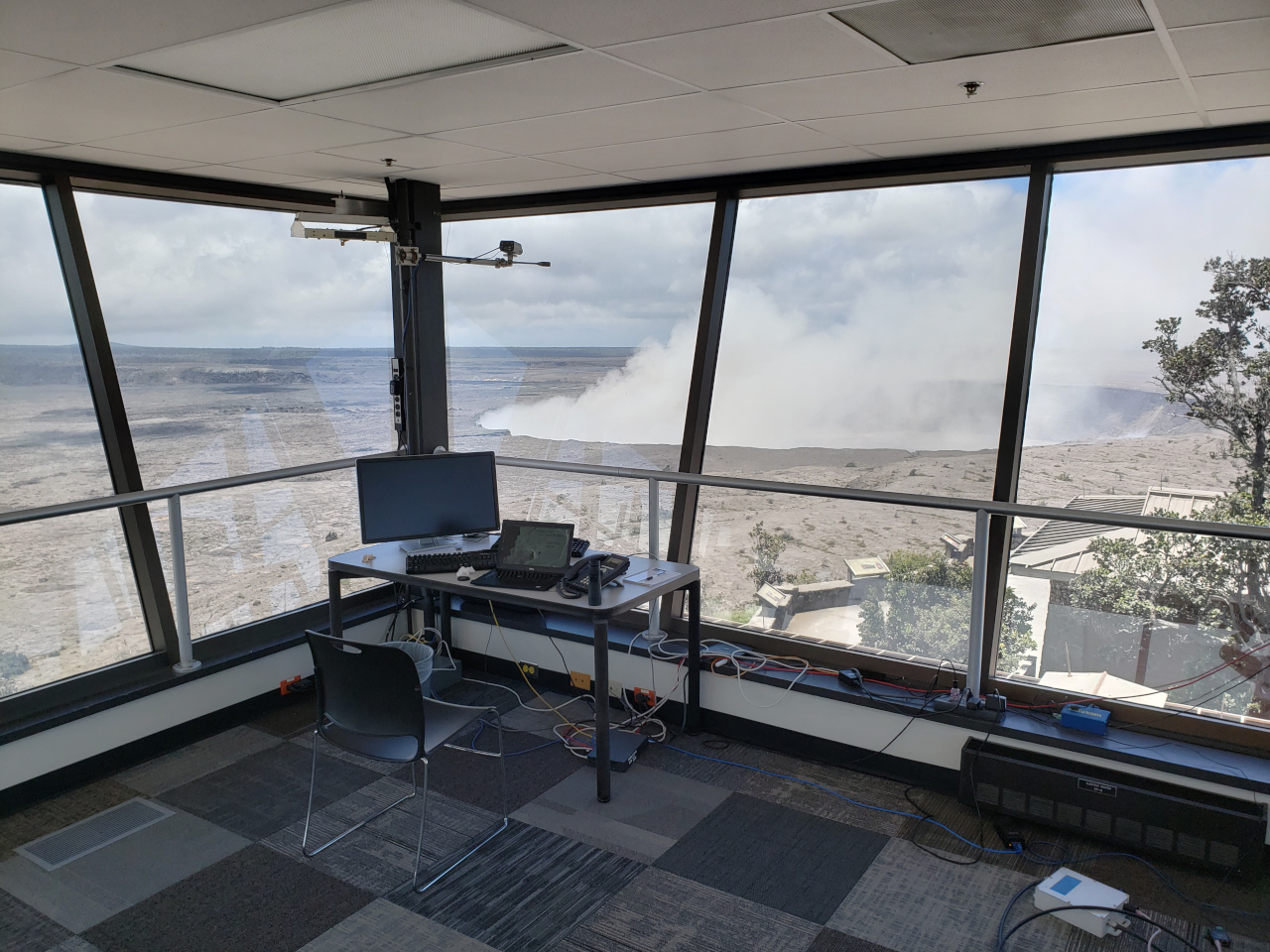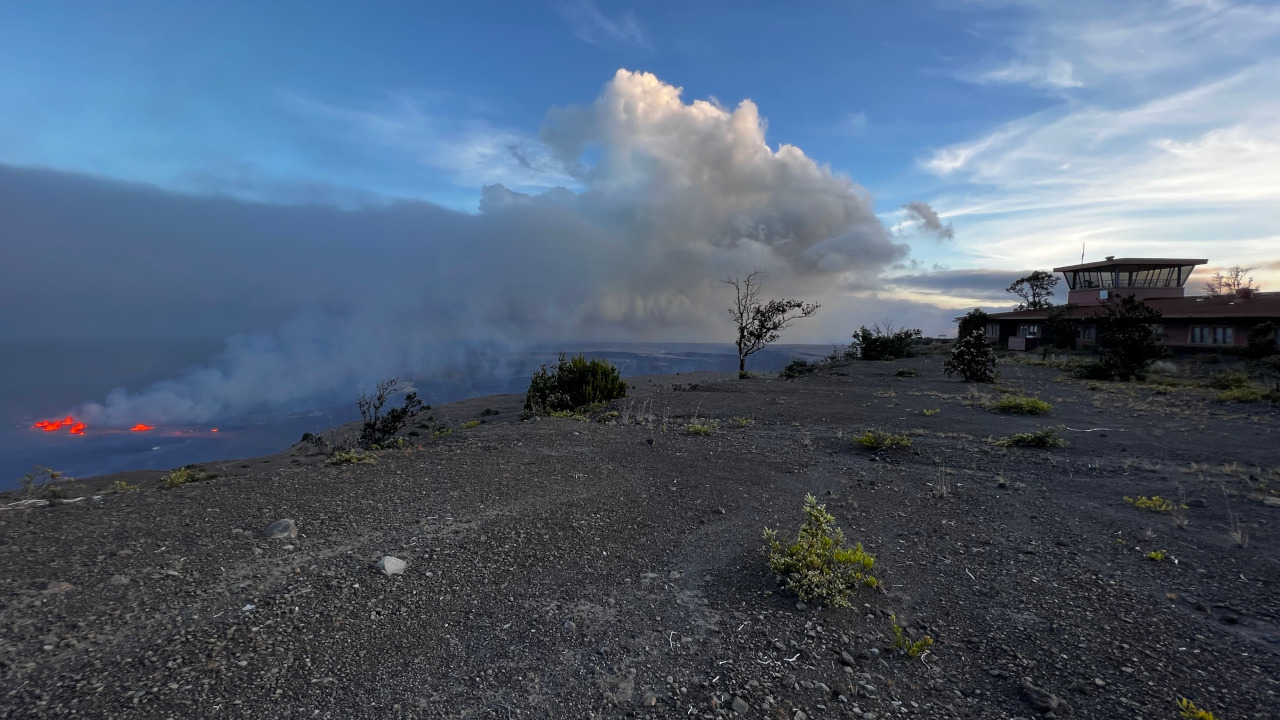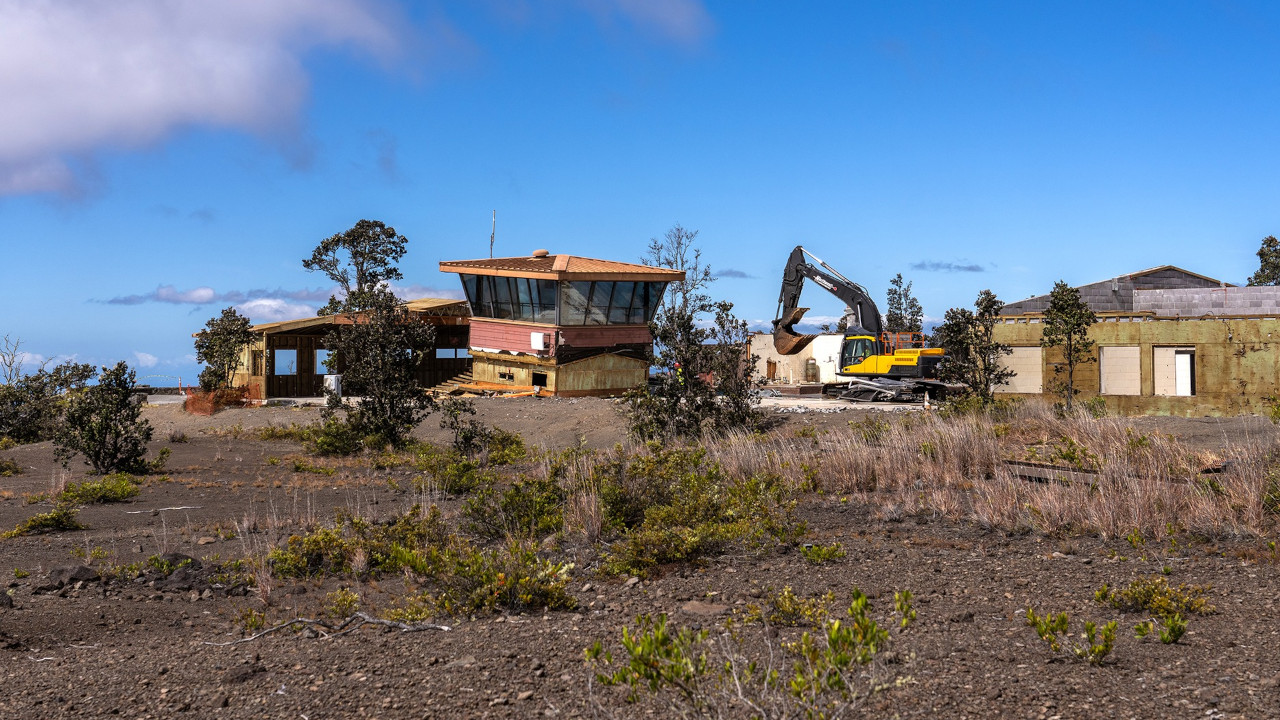
NPS: “This USGS webcam image shows the deconstruction site at Uēkahuna. Note the expansive views of Kīlauea caldera and Halemaʻumaʻu, no longer blocked by the facilities.”
(BIVN) – The National Park Service museum and Hawaiian Volcano Observatory buildings no longer stand at the edge of Kīlauea caldera.
“The Tower is down,” wrote the National Park Service in a July 26th social media post. “The last earthquake-ravaged building on the Uēkahuna bluff in Hawaiʻi Volcanoes National Park has been removed. Workers took less than an hour Friday morning to drop and dismantle the USGS Hawaiian Volcano Observatory (HVO) Observation Tower. The tower stood next to Jaggar Museum, and until the 2018 eruption and summit collapse, provided scientists with a 360-degree vantage point for studying Kīlauea and Mauna Loa volcanoes.”
The latest Volcano Watch article looks back on the buildings that served as a base of operations for the geologists monitoring Kīlauea volcano over the years.
From this week’s article, written by U.S. Geological Survey Hawaiian Volcano Observatory scientists and affiliates:
“Time to go”… words that none of us at the USGS Hawaiian Volcano Observatory (HVO) wanted to hear.
It was May 16, 2018, and HVO staff had been in the throes of monitoring Kīlauea’s lower East Rift Zone eruption and summit caldera collapse for the previous two weeks. HVO’s building—located on the rim of Kaluapele (Kīlauea’s summit crater) was being shaken apart by as many as 400 earthquakes per day. Cracks in the floors and walls enlarged and multiplied as did concern for HVO staff working there, until those inevitable words were spoken. As we reluctantly left our offices that day, little did we know that we’d never work there again.

USGS: “A view of Halemaʻumaʻu from within the USGS Hawaiian Volcano Observatory tower at the Uēkahuna bluff in Hawaiʻi Volcanoes National Park. The tower, which has been removed, provided views of Kaluapele (Kīlauea’s summit caldera), the upper portion of the rift zones, and Mauna Loa.” (USGS photo taken on May 18, 2018)
HVO staff, from 1948 through 2018, realized what a privilege and inspiration it was to work within Hawaiʻi Volcanoes National Park from the buildings at Uēkahuna. The site provided spectacular views from which we could readily observe Kaluapele and Kīlauea’s upper rift zones. Hundreds of volunteers and visiting scientists from around the world, as well as countless students came to HVO to learn about and experience the only USGS observatory located at the summit of an active volcano.
Volcanoes rarely erupt at the convenience of humans, so HVO staff must sometimes work around the clock when monitoring an eruption. As a result, HVO’s building was like a second home to many staff, so its loss feels personal.
Deconstruction of HVO’s building at Uēkahuna is now almost complete. For all of us who worked there, saying that we are sad is a profound understatement. The loss of such an iconic facility is truly the end of an era.
We take comfort in knowing that part of the building was taken down in such a way that materials from it can be used elsewhere. For example, rocks from its outer walls are being used in the construction of HVO’s new field station near Kīlauea Military Camp in the National Park. Like the former buildings at Uēkahuna, the new field station will allow HVO staff to reach field sites on Kīlauea within minutes, when necessary, to repair monitoring instruments or document volcanic activity.
Another USGS facility, currently under construction at the University of Hawaiʻi at Hilo, will provide office and lab space for HVO and the USGS Pacific Island Ecosystems Research Center (PIERC). Until then, HVO continues to fulfill its mission from temporary quarters in Hilo and Keaʻau.
As HVO transitions to new environs, those of us who worked from the buildings on the rim of Kaluapele are grateful for the experience and fondly remember our years there.

USGS: “The former USGS Hawaiian Volcano Observatory building, perched on Kīlauea caldera rim, had spectacular views of the summit eruption. The tower was built with a vision of overlooking eruptions such as this one. This building was damaged during the 2018 summit collapse and was removed in 2024.” (USGS photo by C. Gansecki)
HVO staff, from 1948 through 2018, realized what a privilege and inspiration it was to work within Hawaiʻi Volcanoes National Park from the buildings at Uēkahuna. The site provided spectacular views from which we could readily observe Kaluapele and Kīlauea’s upper rift zones. Hundreds of volunteers and visiting scientists from around the world, as well as countless students came to HVO to learn about and experience the only USGS observatory located at the summit of an active volcano.
Volcanoes rarely erupt at the convenience of humans, so HVO staff must sometimes work around the clock when monitoring an eruption. As a result, HVO’s building was like a second home to many staff, so its loss feels personal.
Deconstruction of HVO’s building at Uēkahuna is now almost complete. For all of us who worked there, saying that we are sad is a profound understatement. The loss of such an iconic facility is truly the end of an era.
We take comfort in knowing that part of the building was taken down in such a way that materials from it can be used elsewhere. For example, rocks from its outer walls are being used in the construction of HVO’s new field station near Kīlauea Military Camp in the National Park. Like the former buildings at Uēkahuna, the new field station will allow HVO staff to reach field sites on Kīlauea within minutes, when necessary, to repair monitoring instruments or document volcanic activity.
Another USGS facility, currently under construction at the University of Hawaiʻi at Hilo, will provide office and lab space for HVO and the USGS Pacific Island Ecosystems Research Center (PIERC). Until then, HVO continues to fulfill its mission from temporary quarters in Hilo and Keaʻau.
As HVO transitions to new environs, those of us who worked from the buildings on the rim of Kaluapele are grateful for the experience and fondly remember our years there.
“Special memories and ranger talks will continue at Uēkahuna – just without the buildings,” the National Park Service wrote in a social media post. “Scientists will continue to monitor the world’s most active volcanoes, eventually they will work from the new USGS HVO Field Station just a mile down the road (and waaaay back from the crater’s edge). The wahi pana (storied place) of Uēkahuna will continue to evolve, just like Kīlauea.”


by Big Island Video News6:46 pm
on at
STORY SUMMARY
HAWAIʻI VOLCANOES NATIONAL PARK - The Jaggar Museum and the USGS HVO Observation Tower have been removed from the Uēkahuna bluff at the Kīlauea volcano summit.